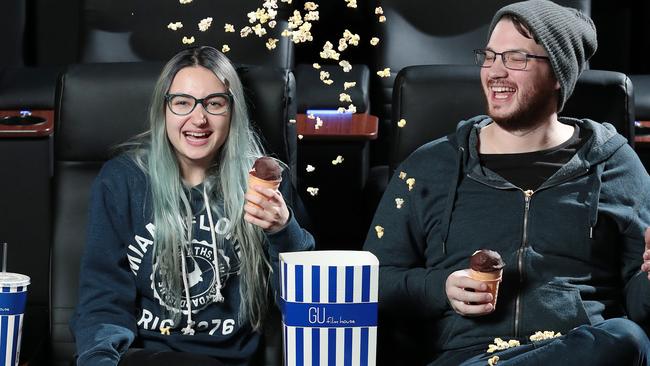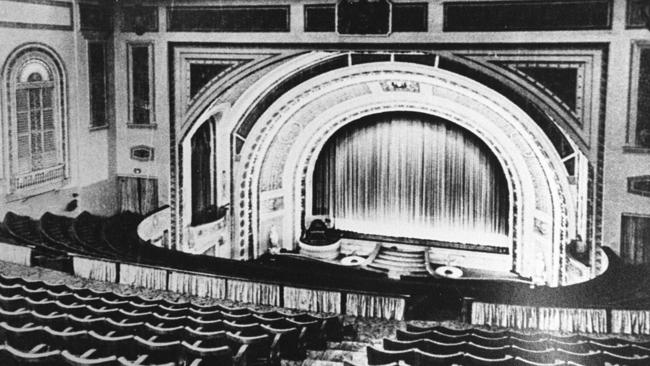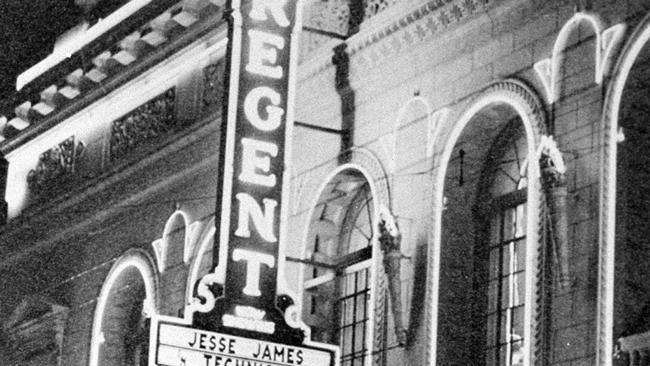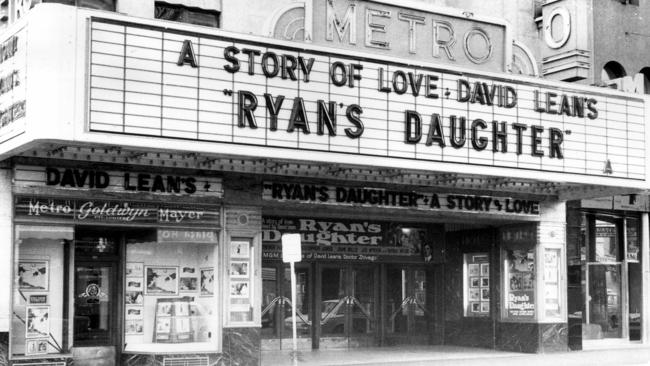Adelaide cinema’s new golden age
WE may be watching screens differently but our love for a night at the movies is undimmed. Cinema providers believe our love for cinema will live on.

OUR attraction to cinema is a never-ending love story. Australians have always enjoyed a night at the cinema, popcorn in hand, and although their love for it has grown up and changed and been challenged, it has never lost its magic.
And it is magic. People speak in hushed tones not just about the first time they saw Star Wars and what it was like, but which cinema they saw it at and who they were with.
No one speaks fondly about the first time they downloaded Star Wars: The Force Awakens, with Croatian subtitles, and how they watched it in on their own, in their pyjamas, in bed.
We are in the midst of an unstoppable entertainment revolution as screens take on new meanings and people watch movies on their phone.
But in Adelaide, a film theatre revolution is saying very loudly that cinemas are backing themselves as a permanent part of the landscape, no matter how much our screen habits change.
“Nothing beats going to the cinema,” says GU area general manager Anthony Kierann.

“I don’t think there is an individual who enjoys going to the cinema who would argue there is a better experience than seeing a film with a big screen and big sound.”
In the East End at Palace Nova, the message is the same.
“Australians are big moviegoers and, although there is now so much competition for our time, cinema is still a much-loved activity,” says Palace Cinema head Benjamin Zeccola.
“I’m really looking forward to the latest census data which covers film and movie going.”
Apart from renovations and overhauls, Adelaide last year got a new GU cinema at Glenelg, which filled a gap in the market, and late this year will have a brand new Palace Nova at Prospect.
In addition, an overhaul at Palace Nova East End closed the boutique Nova but increased the overall number of screens across the road.
GU, formerly Greater Union, is behind the new cinema at Glenelg where, in 2009, the old movie theatre on Jetty Rd closed after 60 years.
Cinemagoers had been left stranded when the old Wallis art deco brick cinema, originally the Ozone, closed with a final screening of Gone With the Wind, six decades after it opened with Judy Garland in A Star is Born in 1937.
It took more than four years but just around the corner from Jetty Rd, off Partridge St, is a $17 million cinema development with six screens and a cluster of cafes and shops. Film lovers in the area who were having to hike to Marion breathed a sigh of relief.
“Glenelg is the suburbs but it’s like going on holidays,” Mr Kierann says.
“It caters very strongly for families, so there is some content that might work at Glenelg but not at Adelaide, and vice versa.”
Glenelg was a safe bet with a strong catchment zone, but the GU Filmhouse on the site of the city’s old Hindley Cinema is much more ambitious statement of faith in the future of screens.
It cost about $8 million, has two auditoriums with the only Dolby Atmos surround sound in town, and the biggest screens.

It is also in an unfashionable part of Hindley St, where the old theatre closed in 2008 leaving Palace Nova as the only cinema in town after the Hindmarsh Academy had shut a year earlier.
Mr Kierann likes to call the area grunge. “It’s all in how you embrace it and develop it,” he says.
“There are grunge parts in Melbourne and Sydney, and it’s not about using it as a negative but thinking how can we work with it being a thread within the exciting tapestry of the West End and the local business communities.”
GU is being proactive and has not just opened its doors hoping people will come. It is working with the Lord Mayor and Adelaide City Council to tap into how the area will develop, and it is focusing on special events and niche film strands, including Asian movies for students in the West End – experiences they see as defining GU.
“It’s an opportunity to be an artistic hub, we’re involved with the Fringe, we had a comedy night a month ago that was very successful,” Mr Kierann says.
As well becoming the new hub for the October Adelaide Film Festival, taking over from the Palace Nova, the GU Hindley Filmhouse will next month be overrun by student filmmakers attending the first Adelaide International Youth Film Festival.
This ambitious event has serious international connections, with backing from the major China-based funding group YOLO China Investment and a sister relationship with Italy’s prestigious Giffoni Film Festival, which each year attracts stars, directors and young movie makers from 39 countries.
South Australia has a delegation at Giffoni – attended this year by Hollywood stars Amy Adams and Bryan Cranston – and a special delegation from Italy will be at the September event.
Mr Kierann is taking it slowly and the strategy is a careful one, but audiences are building. A recent weekend screening of cult anime classic from the 1980s, Akira, sold out two auditoriums with 450 admissions.
“We all talk about Netflix and Stan but all I believe they are doing is taking over TV, which is almost obsolete now,” he says. “It doesn’t stop people wanting to go to the movies. I’m pretty excited.”
On the eastern side of town, Palace Nova has rethought its screens and how they were being used.
Mr Zeccola says the 15-year lease was up on the Nova, whose copper sign was a landmark and its rounded purple chairs a new kind of comfortable.
The problem with having two cinemas with multiple screens on either side of the street (apart from working out where you were meant to be) was that it duplicated overheads, including staff. As a result, the Nova’s lease died a natural death and the screens are now all under the Palace roof.
“It wasn’t a question of downsizing, it was about maintaining choice but doing it differently,” Mr Zeccola says.
Since the Nova and Palace opened with four cinemas on one side and three on the other, digital technology has dramatically reduced the minimum size of theatres.
Making use of that, the Palace has increased the overall number of screens, from 10 to 12, but built smaller cinemas, some as intimate as 20 seats.
Its programming is a mix of blockbuster and arthouse and some of the films attract loyal viewers who are few in number.
Mr Zeccola says weekends are busy, so is Friday night, but Monday to Thursday, particularly during the day, can be very quiet. And cinemas are typically vast spaces in high-traffic areas that demand a high rent.
Smaller cinemas greatly improve programming flexibility so that a big seller can be on in more than one theatre with staggered opening times 15 or 20 minutes apart. As numbers fall, the film moves to the smaller theatres.
“People vote with their feet, so the films that are achieving the highest admissions will be in the cinemas with the largest number of seats,” Mr Zeccola says.
While people keep coming, the movie stays on, which explains why a small but popular choice like the American horror film Get Out can open in early May and still be showing.

But it is on only twice a day at odd times, while Dunkirk has four sessions and Baby Driver five.
“If a film is popular we will hold onto it as long as we can afford to,” Mr Zeccola says.
“Even if they are attracting more moderate audiences, we can hold on for longer.”
Anyone driving along Prospect Rd cannot but notice the distinctively curved, art deco Prospect Palace Nova Cinema taking shape.
This is a breakaway concept based on Prospect’s movie-loving demographic and made possible because of the $20 million retail development by Theo Maras, who wanted cinema at its heart.
Mr Zeccola says they were able to come to terms with Mr Maras based on the fruitful Prospect and North Adelaide catchment areas. They are banking on a quality local cinema persuading people who would be patrons of the Palace Nova East End going to the theatre more.
“It’s not far from town but Prospect has an ideal catchment area of people we think are ideally suited to being Palace Nova customers in Adelaide,” Mr Zeccola says.
It promises a quality experience – wine and cheese, popcorn in olive oil – with large and comfortable leather seats and 14 cinemas ranging in size from 24 to 161 seats.
Palace Nova has the added advantage of being home to a cycle of popular film festivals, including the French, Italian, Spanish, British and the Scandinavian festivals.
This is a thoughtful, independent, niche cinema for older people, not just blockbusters for teenage boys.
The market is fracturing and screen providers are having to adapt, but the familiar ritual of a night at the cinema with new-release trailers giving a teaser of what is to come seems to be thriving.
“As my father says, every house has a kitchen but there are still thousands of restaurants in every town,” Mr Zeccola says.
“It’s the same with movies. You can invite your partner to come and sit on the couch and watch something, or you can take them out to the movies.”
